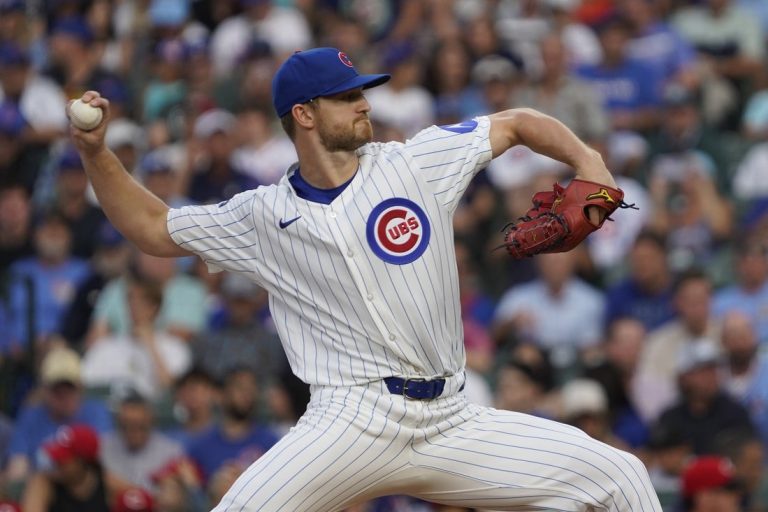DENVER — The impacts of playing at Coors Field’s altitude of 1,580 metres above sea level are, in the words of Toronto Blue Jays manager John Schneider, “a real thing.” Big breaking balls don’t really break. There are little oxygen tanks in the dugout, just in case someone needs some help catching their breath after a first-to-home dash. And yeah, the ball really does travel further, so much so that Daulton Varsho actually plays shallower here to take away hits in front of him, since anything over his head “more than likely is going to be gone.”
Visitors need to account for the conditions then, but “you don’t want to play too much into it,” cautioned Schneider. Pitchers may need to adjust their usages, “but you’re still going to pitch your game,” said pitching coach Pete Walker. Baseball in thin air is still baseball, “you just have to be really conscious of what you do here.”
The Blue Jays did all of the above Monday night, righting themselves after a rare off-week in a thorough 15-1 thrashing of the Colorado Rockies. Varsho hit a three-run homer during a seven-run third that was capped by Bo Bichette’s two-run homer, while the star shortstop added a three-run drive during a five-run seventh. Ernie Clement had a career-high five hits, Nathan Lukes three, each scored three times, while everyone in the starting lineup had at least one hit.
And, in perhaps the most telling indicator of how well the Blue Jays adapted to Denver, Eric Lauer allowed a single run on seven hits and a walk over six strong innings, shaking off some dreadful career numbers. In seven previous starts at Coors Field, the lefty had an ERA of 12.73 in 23.1 innings, allowing 45 hits and 16 walks with 23 strikeouts, as the Rockies batted .395/.469/.667 in 131 plate appearances against him.
Alejandro Kirk picked off catcher counterpart Hunter Goodman at first with two on and one out in the bottom of the first, helping Lauer escape that inning unscathed, and the Rockies didn’t mount a real threat again.
The victory pushed the Blue Jays to 66-48 and was just their third in the last nine games, a dry spell that followed an 8-2 run out of the all-star break against San Francisco, the Yankees and Detroit. They did exactly what a division leader should do to a Rockies team that, at 30-82, is inept enough to challenge the 2024 White Sox’s record of 121 losses, crisp in a way they weren’t during consecutive series losses to the Orioles and Royals.
“You match up against certain teams, certain ways, in Baltimore and Kansas City, they didn’t let us breathe that much,” said Schneider. “There weren’t very many mistakes to hit. We made a few of our own, both on the mound and in the field. So we’ve got to get back to taking care of the ball for one, and trying to continue to have productive innings, offensively. I don’t know if we were in (a funk). These guys are really good at turning the page.”
Perhaps Lauer, most of all, given his track record at Coors Field.
His curveball, precisely the type to be impacted by the altitude, is a key pitch for him, one he uses 25.7 per cent of the time in putaway situations, with a 29.2 per cent whiff rate. He threw 16 of them against the Rockies, especially once the Blue Jays opened up a 9-0 lead in the top of the third, giving him a needed complement to the 31 fastballs and 30 cutters he primarily relied on.
In that way, he heeded the advice of Walker, who said pitchers must “get a feel for the park and the air as quickly as possible.”
“The catcher’s got to lead,” he continued. “It’s an unforgiving park, so there’s less room for error, that’s all there is to it. Curveballs, you’ve got to get it figured out when you’re warming up, where it’s starting and where it’s ending, and then be able to repeat that out there, which is not easy. But the guys that lose their aggressiveness and pitch afraid and get behind in the count 1-0, 2-0, 2-1, get hammered.”
Lauer did not get hammered, and while he got strong defensive plays from Varsho in the fourth, who ran in to snare a soft Warming Bernabel liner, and in the fifth from Lukes, who chased down a Kyle Farmer smash by the warning track in right, he really minimized hard contact.
Varsho’s catch, in particular, offered proof of concept for his approach to defending at Coors.
“A lot of people would think, oh the ball flies here, you have to play deep, but it’s actually the opposite,” he explained. “There are more hits that are going to fall in front of you than balls that are going to be hit over your head. We’re here to basically eliminate what our pitchers do well and that’s get soft contact. We don’t cover mistakes.”
Those belonged mainly to the Rockies, who burned through only three relievers behind starter Tanner Gordon, who allowed seven runs in 2.2 innings. The Blue Jays, after a week of not seeing much good hitting, feasted at the buffet all night long.
“There’s kind of never enough runs here, you know what I mean?” Schneider said before the game. “It’s a big field. There are a lot of hits here and there are a lot of spots for the ball to fall. And this team can hit. I remember the series here two years ago. It was kind of a cluster. There was (stuff) flying everywhere. You’ve got to continue to score as much as you can, you can’t let your guard down as a starter or a guy coming in.”
Not an issue Monday night.






